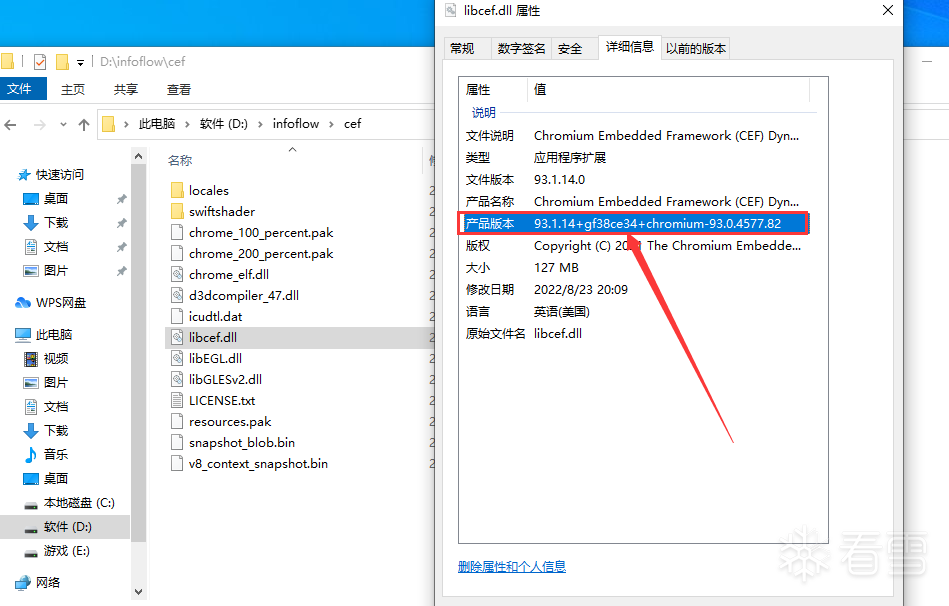
本文为看雪论坛精华文章
看雪论坛作者ID:橘喵Cat
一
前言
二
初步环境准备
去官网找对应的libcef+chromium版本即可:https://cef-builds.spotifycdn.com/index.html下载框架
在windows上下载好后,直接解压即可。
三
找到js资源文件所在
cef_stream_reader_create_for_data
cef_stream_reader_create_for_file
然后输入自己的账户密码登录,登录成功后,过了一会断点才来,经过测试,发现断点只断这么一次。根据寄存器ECX~EDI的值定位到内存,发现多个资源路径(所有寄存器对应内存都看一下)。
第二张和第三张图片可以省略,因为这俩资源文件在第一张路径里都有,找到第一张的路径,发现是个加密的zip。
四
解密资源文件
cef_zip_reader_create从zip文件读取数据。
///// All ref-counted framework structures must include this structure first.///typedef struct _cef_base_ref_counted_t {///// Size of the data structure.///size_t size;///// Called to increment the reference count for the object. Should be called// for every new copy of a pointer to a given object.///void(CEF_CALLBACK* add_ref)(struct _cef_base_ref_counted_t* self);///// Called to decrement the reference count for the object. If the reference// count falls to 0 the object should self-delete. Returns true (1) if the// resulting reference count is 0.///int(CEF_CALLBACK* release)(struct _cef_base_ref_counted_t* self);///// Returns true (1) if the current reference count is 1.///int(CEF_CALLBACK* has_one_ref)(struct _cef_base_ref_counted_t* self);///// Returns true (1) if the current reference count is at least 1.///int(CEF_CALLBACK* has_at_least_one_ref)(struct _cef_base_ref_counted_t* self);} cef_base_ref_counted_t;///// Structure that supports the reading of zip archives via the zlib unzip API.// The functions of this structure should only be called on the thread that// creates the object.///typedef struct _cef_zip_reader_t {///// Base structure.///cef_base_ref_counted_t base;///// Moves the cursor to the first file in the archive. Returns true (1) if the// cursor position was set successfully.///int(CEF_CALLBACK* move_to_first_file)(struct _cef_zip_reader_t* self);///// Moves the cursor to the next file in the archive. Returns true (1) if the// cursor position was set successfully.///int(CEF_CALLBACK* move_to_next_file)(struct _cef_zip_reader_t* self);///// Moves the cursor to the specified file in the archive. If |caseSensitive|// is true (1) then the search will be case sensitive. Returns true (1) if the// cursor position was set successfully.///int(CEF_CALLBACK* move_to_file)(struct _cef_zip_reader_t* self,const cef_string_t* fileName,int caseSensitive);///// Closes the archive. This should be called directly to ensure that cleanup// occurs on the correct thread.///int(CEF_CALLBACK* close)(struct _cef_zip_reader_t* self);// The below functions act on the file at the current cursor position.///// Returns the name of the file.///// The resulting string must be freed by calling cef_string_userfree_free().cef_string_userfree_t(CEF_CALLBACK* get_file_name)(struct _cef_zip_reader_t* self);///// Returns the uncompressed size of the file.///int64(CEF_CALLBACK* get_file_size)(struct _cef_zip_reader_t* self);///// Returns the last modified timestamp for the file.///cef_basetime_t(CEF_CALLBACK* get_file_last_modified)(struct _cef_zip_reader_t* self);///// Opens the file for reading of uncompressed data. A read password may// optionally be specified.///int(CEF_CALLBACK* open_file)(struct _cef_zip_reader_t* self,const cef_string_t* password);///// Closes the file.///int(CEF_CALLBACK* close_file)(struct _cef_zip_reader_t* self);///// Read uncompressed file contents into the specified buffer. Returns < 0 if// an error occurred, 0 if at the end of file, or the number of bytes read.///int(CEF_CALLBACK* read_file)(struct _cef_zip_reader_t* self,void* buffer,size_t bufferSize);///// Returns the current offset in the uncompressed file contents.///int64(CEF_CALLBACK* tell)(struct _cef_zip_reader_t* self);///// Returns true (1) if at end of the file contents.///int(CEF_CALLBACK* eof)(struct _cef_zip_reader_t* self);} cef_zip_reader_t;///// Writes the contents of |src_dir| into a zip archive at |dest_file|. If// |include_hidden_files| is true (1) files starting with "." will be included.// Returns true (1) on success. Calling this function on the browser process UI// or IO threads is not allowed.///CEF_EXPORT int cef_zip_directory(const cef_string_t* src_dir,const cef_string_t* dest_file,int include_hidden_files);///// Create a new cef_zip_reader_t object. The returned object's functions can// only be called from the thread that created the object.///CEF_EXPORT cef_zip_reader_t* cef_zip_reader_create(struct _cef_stream_reader_t* stream);
然后重新启动如流,登录,进入头像修改页面,结果直接给我乱码了。然后尝试了下啥也不改,只要是替换了,就会乱码。凉凉,估计加载资源文件的时候有校验,比如它的修改时间、MD5、编码等等。不过还是证明了修改文件会造成影响。
五
开启CEF框架调试功能
// dllmain.cpp : 定义 DLL 应用程序的入口点。#include "pch.h"#include "detours/detours.h"#include "include/capi/cef_browser_capi.h"#include "include/internal/cef_types_win.h"#include "include/capi/cef_client_capi.h"#include "include/internal/cef_win.h"#include <Windows.h>PVOID g_cef_browser_host_create_browser = nullptr;PVOID g_cef_get_keyboard_handler = NULL;PVOID g_cef_on_key_event = NULL;void SetAsPopup(cef_window_info_t* window_info) {window_info->style =WS_OVERLAPPEDWINDOW | WS_CLIPCHILDREN | WS_CLIPSIBLINGS | WS_VISIBLE;window_info->parent_window = NULL;window_info->x = CW_USEDEFAULT;window_info->y = CW_USEDEFAULT;window_info->width = CW_USEDEFAULT;window_info->height = CW_USEDEFAULT;}int CEF_CALLBACK hook_cef_on_key_event(struct _cef_keyboard_handler_t* self,struct _cef_browser_t* browser,const struct _cef_key_event_t* event,cef_event_handle_t os_event) {OutputDebugStringA("[detours] hook_cef_on_key_event \n");auto cef_browser_host = browser->get_host(browser);// 键盘按下且是F12if (event->type == KEYEVENT_RAWKEYDOWN && event->windows_key_code == 123) {cef_window_info_t windowInfo{};cef_browser_settings_t settings{};cef_point_t point{};SetAsPopup(&windowInfo);OutputDebugStringA("[detours] show_dev_tools \n");// 开启调试窗口cef_browser_host->show_dev_tools(cef_browser_host, &windowInfo, 0, &settings, &point);}return reinterpret_cast<decltype(&hook_cef_on_key_event)>(g_cef_on_key_event)(self, browser, event, os_event);}struct _cef_keyboard_handler_t* CEF_CALLBACK hook_cef_get_keyboard_handler(struct _cef_client_t* self) {OutputDebugStringA("[detours] hook_cef_get_keyboard_handler \n");// 调用原始的修改get_keyboard_handler函数auto keyboard_handler = reinterpret_cast<decltype(&hook_cef_get_keyboard_handler)>(g_cef_get_keyboard_handler)(self);if (keyboard_handler) {// 记录原始的按键事件回调函数g_cef_on_key_event = keyboard_handler->on_key_event;// 修改返回值中的按键事件回调函数keyboard_handler->on_key_event = hook_cef_on_key_event;}return keyboard_handler;}int hook_cef_browser_host_create_browser(const cef_window_info_t* windowInfo,struct _cef_client_t* client,const cef_string_t* url,const struct _cef_browser_settings_t* settings,struct _cef_dictionary_value_t* extra_info,struct _cef_request_context_t* request_context) {OutputDebugStringA("[detours] hook_cef_browser_host_create_browser \n");// 记录原始的get_keyboard_handlerg_cef_get_keyboard_handler = client->get_keyboard_handler;// 修改get_keyboard_handlerclient->get_keyboard_handler = hook_cef_get_keyboard_handler;return reinterpret_cast<decltype(&hook_cef_browser_host_create_browser)>(g_cef_browser_host_create_browser)(windowInfo, client, url, settings, extra_info, request_context);}// Hook cef_browser_host_create_browserBOOL APIENTRY InstallHook(){OutputDebugStringA("[detours] InstallHook \n");DetourTransactionBegin();DetourUpdateThread(GetCurrentThread());g_cef_browser_host_create_browser =DetourFindFunction("libcef.dll", "cef_browser_host_create_browser");DetourAttach(&g_cef_browser_host_create_browser,hook_cef_browser_host_create_browser);LONG ret = DetourTransactionCommit();return ret == NO_ERROR;}BOOL APIENTRY DllMain( HMODULE hModule,DWORD ul_reason_for_call,LPVOID lpReserved){switch (ul_reason_for_call){case DLL_PROCESS_ATTACH:InstallHook();break;case DLL_THREAD_ATTACH:case DLL_THREAD_DETACH:case DLL_PROCESS_DETACH:break;}return TRUE;}
于是我在exe运行的时候,使用远程线程注入dll,成功。
登录进去,尝试在某些页面里,按F12,可以开启Chrome调试窗口,非常的方便。
六
尝试做点什么功能+总结(未遂)
看了下页面元素构成,很明显不行,因为值是以文本形式夹在div标签里面,并不能触发脚本语言。
那好吧,我去找个存放在标签里面的值修改吧,可以看到,昵称是会写到value值下的。
那我们把它改成攻击代码,将value用"给闭合,然后设置一个鼠标事件,当鼠标移动到框内时,就会弹窗。
结果并没有弹,查看html源码,发现"已经被编码成"
看来安全措施做的挺到位嘛,那我也就止步于此了。
看雪ID:橘喵Cat
https://bbs.pediy.com/user-home-940656.htm
2.5折门票限时抢购
峰会官网:https://meet.kanxue.com/kxmeet-6.htm
# 往期推荐
球分享
球点赞
球在看
点击“阅读原文”,了解更多!
文章来源: http://mp.weixin.qq.com/s?__biz=MjM5NTc2MDYxMw==&mid=2458473847&idx=1&sn=ad73bc3a39d01fbdc0ef69f51e1f7606&chksm=b18e65fd86f9ecebedc7b8244af1252aebc923f97c01338211dc7a9ae52c5f212cab4ab1f467#rd
如有侵权请联系:admin#unsafe.sh
如有侵权请联系:admin#unsafe.sh